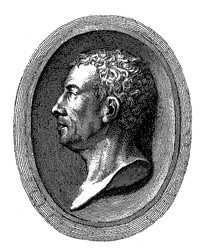Sisto Badalocchio (um 1585-1647), ein Schüler von Annibale Carracci, schuf die Grafik nach einer Vorlage von Andrea Vaccari aus dem Jahr 1606, also exakt hundert Jahre nach Entdeckung der Laokoon-Gruppe. Mittlerweile ist das antike Meisterwerk so häufig gezeichnet worden, dass die unterschiedlichen Bildvorlagen eigene Rezeptionslinien entwickelten. Dem druckgrafischen Medium entsprechend ist Badalocchios Stich seitenverkehrt.
u.l.: Sisto Ba. F
u.r.: Andreas Vaccarius formis Romae 1606.
Geschenk Dr. Wolfgang von Wangenheim
en

